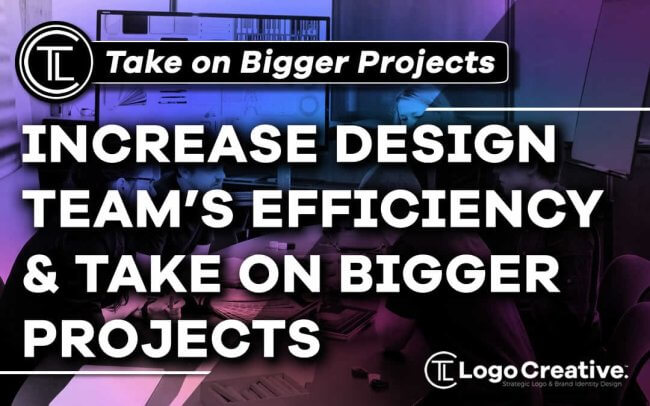Part of growing your graphic design business is bringing in new team members and gradually taking on more complex and more extensive projects. How do you improve your team’s efficiency and speed up turnaround times and results for your clients? In this article we discuss How to Increase Your Design Team’s Efficiency and Take on Bigger Projects.
Bain & Co. says a mere 5% increase in customer retention increases profits by 75% or more. Since happy customers are much more likely to refer their friends and family to your brand, it behoves you to improve your service to your current clients.
In addition to happier customers, you’ll be able to take on bigger projects and complete them on time because you’ll have a team working like a well-oiled machine.
Just what do you need to do to increase your design team’s efficiency? Follow these steps and watch your productivity soar.
Table of Contents
1. Improve Communication
Your team can only work efficiently when they know what you expect and the steps to complete a project. You can quickly improve communication by embracing a project management tool.
Put someone organized and in charge of adding milestones and tasks for each person to complete. The project manager should be on top of every step of the project and touch base with anyone whose work might be late to find out what they need to complete the task on time.
Daily scrum meetings put everyone on the same page and help overcome minor issues before they become significant ones. Encourage open dialogue and reward employees who solve problems.
2. Create a Comfortable Workspace
Some people work better in a quiet environment or with a bit of natural light. The human body takes in 11 million bits of information every second from its surroundings.
In a busy workspace, sound can become almost overwhelming. People can’t do their best work if they feel overwhelmed.
Give your workers some flexibility to work from home, move to another area in the office or have a closed-off space when they need to focus.
Add acoustic panels to reduce reverberating sound, allow workers to wear noise-cancelling headphones or create quiet spaces within your office.
3. Diversify Your Staff
Seek out people as different from one another as possible. If you already have a designer skilled at illustration, look for someone better at photography or shooting videos.
The more diverse your staff, the better brainstorming sessions work.
To improve efficiency, let each person do the work within their wheelhouse. They will work much more quickly when it’s a task they’re comfortable with.
4. Set a Leadership Example
Leaders must set the tone to create a productive work environment. Do your staff members see you giving each project your full attention? You should be at work before anyone else and leave after everyone else.
In addition, keep a positive, upbeat attitude, even when things go wrong. Look for solutions instead of placing blame. If you want your workers to feel part of a team, they must feel their boss and fellow employees have their back, even when they make the inevitable mistake.
Mistakes should be earning experience and a chance to fix problems for future clients.
5. Engage Your Employees
Link somewhere to employee retention stats, according to the United States Bureau of Labor Statistics, job openings increased to a high of 10.9 million over the summer. Employers struggle to fill open positions in many sectors. The last thing you want is to lose loyal workers and have to retain replacements.
You’ll lose time and productivity with each replacement, so your churn rate makes a massive impact on your efficiency and the quality of your follow-through with clients.
Make sure you pay your workers what they’re worth as your revenue allows. Give them extra perks larger corporations can’t provide, such as working from home, on-site day-care or job-sharing opportunities. Look for ways to make your culture more family-like so they won’t want to leave.
6. Look for Places to Improve Workflow
Every company has areas where things stop flowing, and bottlenecks occur. Perhaps your marketing gurus are constantly waiting on your designers to send back drawings. Your sales team isn’t sending over information the minute they land on a new account, or your Finance teams are struggling to keep track of business expenses
Do a complete analysis of your process and see where the stops occur. You should either revisit systems in these areas to improve the workflow or hire additional workers to fill the gap.
7. Gather Feedback
You may feel your design process is as efficient as possible. If customers disagree, you have a problem. Ask for feedback from your clients about the process. Was there anything they felt took longer than it should? Do they have suggestions for improvement?
Keep in mind that most clients may have worked with other design teams in the past and left other firms due to issues. They can tell you what they don’t like, and you can make sure you fix those problems before you lose them, too.
8. Talk to Your Workers
Your employees are the pulse of your company. Talk to them about what they need to make their jobs more efficient. Some may have ideas about software that eases their burden, automation that covers repetitive tasks or tools they need to work more proficiently.
Gather all their ideas and implement what you can afford and make sense. Don’t be afraid to try new things and see what helps the entire team. You can always backtrack and remove something that isn’t working.
With a bit of effort and input from everyone, you’ll become a design machine putting out excellent material for your clients and growing revenue each year.
Join The Logo Community
We hope you enjoyed this article about How to Increase Your Design Team’s Efficiency and Take on Bigger Projects.
If you would like more personal tips, advice, insights, and access to our community threads and other goodies, join us in our community.
You can comment directly on posts, access our community threads, have a discussion and ask questions with our founder Andrew.
If you’re looking to learn more about brand strategy, we highly recommend eRESONAID with our friend and acclaimed brand strategist and author Fabian Geyrhalter, it’s packed full of knowledge and insights you will need to learn to become a brand strategist or apply what you learn within your own business.
 Eleanor Hecks is editor-in-chief at Designerly Magazine. She was the creative director at a prominent digital marketing agency prior to becoming a full-time freelance designer. Eleanor lives in Philadelphia with her husband and pup, Bear.
Eleanor Hecks is editor-in-chief at Designerly Magazine. She was the creative director at a prominent digital marketing agency prior to becoming a full-time freelance designer. Eleanor lives in Philadelphia with her husband and pup, Bear.


